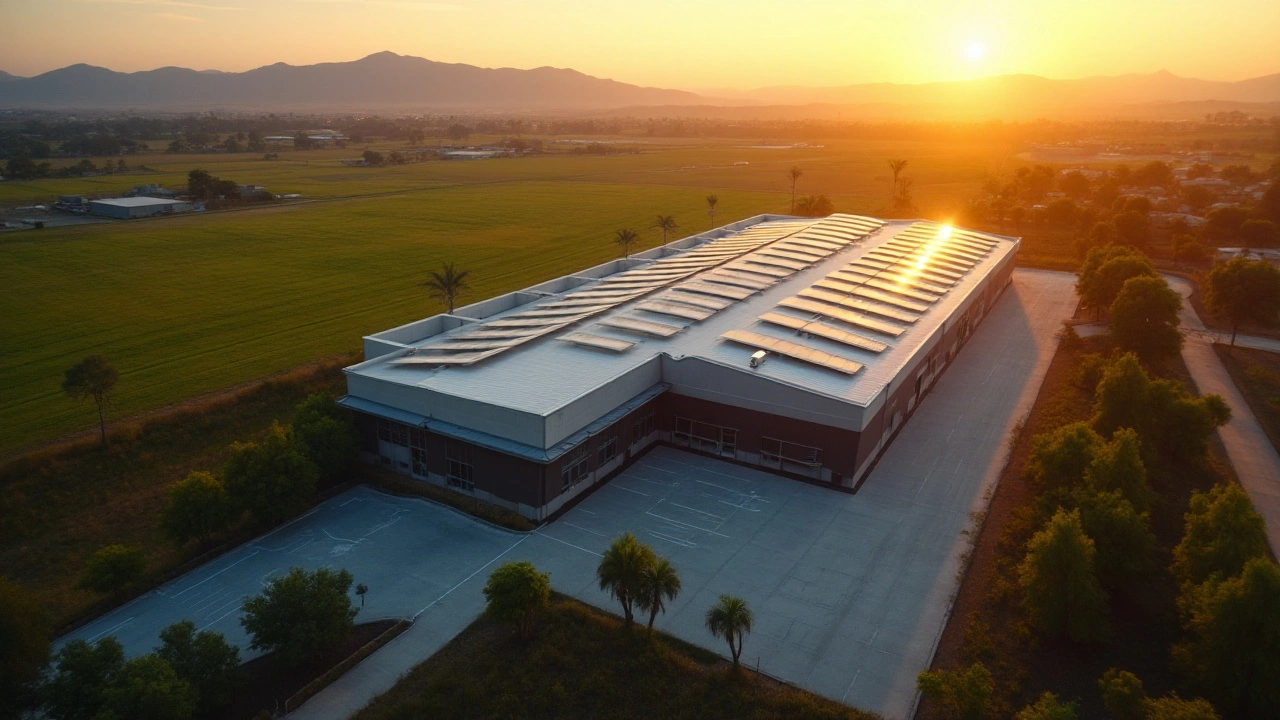When it comes to renting a warehouse in the United States, the costs can significantly differ based on various influential factors. For businesses, understanding these variables is key to making a smart financial decision.
From bustling urban centers to rural landscapes, the location of the warehouse plays a dramatic role in determining rent prices. Each region in the U.S. carries its unique market trends and demands, affecting both availability and cost.
Beyond just the location, factors like warehouse size, accessibility, and amenities contribute to the cost equation. For anyone thinking about leasing, being well-versed in these elements can be the difference between a great deal and an overspend.
- Understanding Warehouse Rent Pricing
- Key Factors Influencing Costs
- Regional Variations in Prices
- Tips for Negotiating Lease Terms
- Maximizing Your Warehouse Investment
Understanding Warehouse Rent Pricing
When examining the intricate world of warehouse rent pricing in the United States, there's much to unravel beyond the mere dollar signs. Pricing for these crucial storage spaces is shaped by a confluence of factors that together create the market dynamics that every business must navigate. One of the key elements influencing rent is the geographical location of the warehouse. For instance, warehouses situated in major cities like Los Angeles or New York typically command higher rental prices compared to those in suburban or rural areas. This discrepancy isn't merely down to the cost of land or property taxes; it's a reflection of the demand and availability unique to each area. The level of industry activity in a given location heavily impacts demand and, consequently, the price tag attached to these properties.
On the surface, a warehouse may seem like an open space surrounded by four walls, but the particulars within can significantly affect rent. Terms like "grade" of the warehouse speak to the facility's construction quality and available amenities, impacting its functionality and price. For instance, warehouses equipped with state-of-the-art security systems, climate-controlled environments, or energy-efficient lighting could be priced higher but offer substantial savings in operation costs and enhanced security. Storage solutions vary widely depending on these elements, so understanding what you need—be it premium features or a more stripped-back facility—is paramount in negotiating the right deal.
Another factor is the size of the warehouse. Larger warehouses can yield economies of scale, presenting relative savings per square foot in contrast to smaller facilities. However, size alone doesn't tell the whole story, as the shape and configuration of a space can limit its functional use, despite a seemingly attractive rent per square foot. The height of the warehouse, which determines vertical storage capabilities, also plays into the cost considerations. A well-dialogued negotiation should consider these spatial logistics to ensure that businesses are not just leasing space, but effectively leasing the right space for their needs.
"The key to securing the best warehouse rental deals is understanding the full spectrum of your requirements and matching them against what the market offers at the moment," notes industry expert J.D. Harper. "It’s not always about cheaper rent but rather about how best that rent serves the needs of your operations."
Lease terms contribute notably to pricing structure, too. Long-term leases might lock renters into more favorable rates, reducing the need for costly and disruptive moves; however, they require a vision of stability and growth. Businesses must weigh the benefits of a stable lease against the flexibility that shorter-term agreements might offer. Landlords often offer incentives such as rent-free periods to attract tenants, particularly in areas with slower demand, which savvy negotiators can leverage to sweeten their deals.
An often-overlooked cost is related to infrastructure taxes and insurance, which might incidentally burden those unprepared. These factors can add unforeseen expenses, impacting the total cost of renting a warehouse. It is crucial to go over contracts meticulously and stay informed about local regulations and potential financial liabilities that could affect business operations.
Key Factors Influencing Costs
Understanding the costs behind renting a warehouse can feel like navigating a labyrinth, with many factors tying into what is essentially the backbone of successful industrial and business operations. One of the most significant influences on rental cost is the location of the warehouse. Warehouses situated in bustling urban areas, particularly near major transportation hubs such as airports and ports, can demand higher rates. This stems from the idea that proximity to these logistics arteries increases efficiency and reduces transportation costs, a valuable advantage for businesses striving for swift delivery times. Conversely, warehouses in more rural or less populated areas might offer lower rents, but they could come with longer transit times and fewer peripheral industrial services.
Size also plays a pivotal role. Larger warehouses tend to have economies of scale, which might deceptively offer lower per-square-foot rates; however, the overall cost will naturally be higher, and one must carefully consider actual space needs to avoid excess spending. The condition of the building—a factor sometimes overlooked—can either inflate or deflate costs. Warehouses outfitted with modern amenities, high-quality insulation, advanced security systems, and energy-efficient designs command higher rents. These features, while an initial cost spike, are a nod toward sustainability and potentially offer long-term savings on utilities and insurance.
Market demand cannot be ignored either. During periods of high demand, such as retail boom seasons or in response to supply chain crises, warehouse costs can temporarily rise as businesses flock to lock down available spaces. Supply is finite, thus an uptick in demand naturally presses prices upwards. Meanwhile, conversely, during downtimes or in a sluggish economy, there may be a noticeable decrease in rent as landlords strive to fill vacant properties.
"The cost of warehouse space is often dictated by what happens in other parts of our society. Economic health, consumer trends, and even remote work patterns alter warehouse demand and prices," notes industry expert John W. Thompson.
For a more analytical approach, consider the financial health of the leasing company or the landlord, as their economic standing can also sway rent costs. If a landlord is carrying substantial debt or feeling the echo of a harsh economic climate, they might offer lower rents to secure tenants quickly. Sometimes, in specific warehouses, rent costs might be deeply tied to logistical considerations like loading dock availability, ceiling height suitable for vertical storage, and floor load capacity. The devil is truly in the details, and these components might decide the fine line between a financially wise decision and a burdensome expense.

Regional Variations in Prices
The landscape of warehouse rent in the United States is as diverse as the nation's geography itself. When it comes to finding the right location, businesses must consider how regional differences can sway prices substantially. It's not just about picking a spot on the map; each area comes with its unique set of economic, logistic, and even climatic influences, all of which can impact the cost of leasing a warehouse.
In bustling metropolitan areas like Los Angeles or New York City, the demand for warehouse spaces often outstrips supply, leading to sky-high rental prices. This is primarily due to the concentration of businesses and the booming e-commerce sector in these urban zones. For instance, the Silicon Valley tech boom has seen warehouse rents in nearby San Francisco soar as tech giants and start-ups scramble for space. Conversely, in more rural states such as Kansas or Iowa, rental costs plummet, partly owing to lessened demand and the availability of expansive land. However, while costs might be lower, other logistical challenges such as transportation and accessibility can add hidden costs.
According to a recent survey conducted by the Cushman & Wakefield real estate firm, the average US warehouse costs range from approximately $4 to $7 per square foot annually in prime locations. In the Midwest, you might snag a deal at the lower end of this spectrum, while on the coasts, the cost may easily tip towards that higher mark.
"The varying costs can be seen as both a challenge and an opportunity," says John Smith, a seasoned real estate analyst. "Understanding these regional dynamics is a powerful tool for any business owner looking to optimize their supply chain logistics."
Another factor to consider is the economic shifts brought on by the pandemic and the ongoing recovery. As remote work continues to rise, some companies are downsizing urban offices, causing a surge in available warehouse spaces. This sudden glut can slightly drive down prices in previously expensive markets, albeit temporarily. Meanwhile, states with tax incentives like Texas and Florida might attract businesses seeking cost-effective solutions, adding another layer to the pricing puzzle.
It's clear that navigating regional variations when leasing a warehouse isn't just about renting a space. It requires a strategic assessment of what each region has to offer in terms of business potential, logistical ease, and future growth prospects. Interested businesses should weigh these factors carefully, as they hold the key to both immediate affordability and long-term profitability.
Tips for Negotiating Lease Terms
When negotiating a warehouse lease, it's vital to walk in armed with knowledge and preparation. Understanding the local market trends in your area is crucial. It's worth researching how much businesses similar to yours are paying for their storage solutions in comparable locations. This gives you a benchmark to gauge whether the offers you're getting are reasonable. Time is your ally in such negotiations—initiate discussions early to avoid rushed decisions under pressure. A strategic approach allows you to explore a variety of options and compare them effectively.
Engage in dialogue about potential inclusions in your lease agreement. For instance, are there maintenance services for shared facilities included, or are utilities considered part of your lease package? Ask about clauses related to rent escalation as well, which can sneak unexpected costs into your operations. It's often a good idea to seek clarification on anything that might seem vague. Clear communication ensures both parties have aligned expectations, reducing the possibility of disputes later on. Remember, the first lease draft is often a starting point, not a final offer, and everything is open for negotiation.
Leverage any unique circumstances that could play to your advantage. A reported surplus of warehouse space in certain regions due to a dip in demand can work in your favor—be sure to mention this during your talks. If you plan to lease a space for a longer term, landlords might be inclined to provide a better rate. Assuming a landlord's perspective can also be helpful; understanding their needs may lead to a mutually beneficial agreement. Consider, if possible, offering a more substantial deposit or prepping your payment schedule to their advantage. A nimble and prepared approach can often tilt situations to your advantage when it comes to negotiations.
"Negotiation is not about winning. It’s about finding the best solution for all parties involved." – Chris Voss, former FBI negotiator
Don’t be shy about bringing in a lawyer who specializes in commercial real estate to review your lease terms before signing. They can spot the red flags that might be a concern in the long run, especially in technical areas like renewal options or exit strategies. Also, seek feedback from others who have gone through the process during your research phase. Learning from someone else's experiences can shed light on aspects you might not have considered. These insights are invaluable, offering practical wisdom gained from actual encounters.
Finally, flexibility shouldn’t mean giving in. Always keep the core needs of your business at the forefront of the discussion. If having flexibility in the use of the space is critical, such as the ability to sublease, make sure these terms are included. The final agreement should reflect a balance where you have secured the best possible package to support your business goals while maintaining a good relationship with the landlord. Moving forward, documenting and reviewing these terms regularly will ensure the leasing relationship runs smoothly over time. It's this balance between informed choices and strategic compromise that sets a solid foundation for successful leasing.

Maximizing Your Warehouse Investment
Investing in a warehouse, whether for leasing or purchasing, is a significant financial decision that calls for strategic planning. One of the first steps in maximizing this investment is to ensure that the space you select aligns closely with your business needs. Consider the type of materials you'll be storing and whether the warehouse accommodates those specific requirements in size and structure. Don't underestimate the importance of location; proximity to major transportation hubs and the target market can significantly optimize your supply chain efficiency.
To further enhance your warehouse investment, you should explore automation technologies. Today’s advancements offer solutions such as automated storage and retrieval systems that reduce operational costs by improving picking efficiency and minimizing human errors. Some businesses have reported improvements of up to 20% in productivity with these technologies. If automation seems like a hefty upfront investment, remember it usually leads to cost savings in the long run, helping to streamline processes and enhance operational workflow.
Warehouse rent considerations also play a critical role. It is advisable to negotiate flexible lease terms. This flexibility can be beneficial if your business experiences seasonal fluctuations or rapid growth, ensuring you are not locked into a facility that doesn’t meet your long-term needs. An often-overlooked aspect is the potential for subleasing; if underused, subleasing can convert empty space into a revenue source, softening your overheads. A creatively negotiated lease can incorporate clauses that consider these possibilities.
"Successful warehouse management is about creating storage solutions that match market demands with innovation. Flexible terms and efficient logistics can bring about unexpected growth," suggests logistics expert Margaret Allen in an insightful piece featured in Supply Chain Management Review.
Pay attention to energy efficiency. Lighting, heating, and cooling costs can add substantial overhead to your warehouse budget. Investing in energy-efficient systems, like LED lighting or solar panels, might represent an initial outlay, but they can result in significant cost savings down the line and are often incentivized by government programs that offer rebates or tax credits for businesses going green. For instance, businesses have reported energy savings of up to 40% by implementing these sustainable measures.
Lastly, regularly evaluate the warehouse's utilization. Implementation of warehouse management software (WMS) can provide insights into space utilization and inventory levels, offering data-driven solutions to maximize your occupancy rate. With a WMS, you can often identify unproductive areas that can be repurposed or optimized for better use. This detailed analysis helps ensure that every square foot of your warehouse is contributing to your operational efficiency and cost-saving goals.





